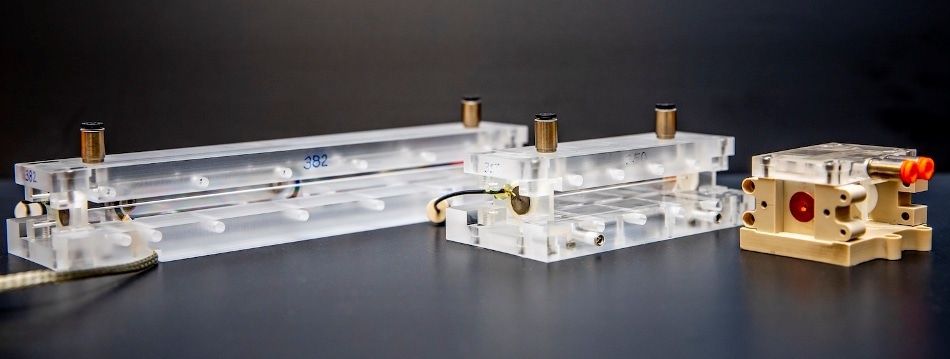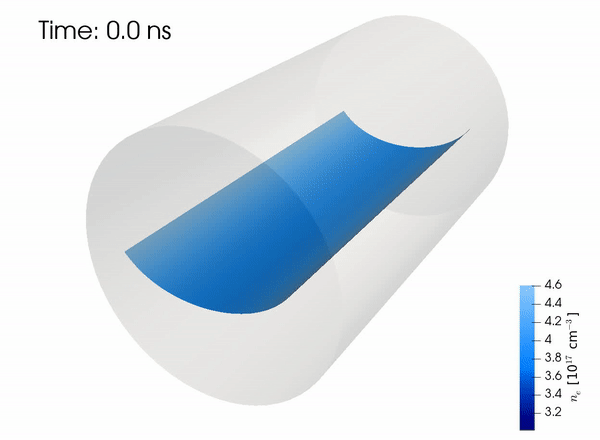Feb 26 2019
Merging a first laser pulse to heat up and “drill” into a plasma, and another to speed up electrons to extremely high energies in just tens of centimeters, researchers have virtually doubled the earlier record for laser-based particle acceleration.
 Different generations of sapphire tubes, called capillaries, are pictured here. The tubes are used to generate and confine plasmas, and to accelerate electrons. A 20-centimeter capillary setup, similar to the one used in the latest experiments, is pictured at left. (Image credit: Marilyn Chung/Berkeley Lab)
Different generations of sapphire tubes, called capillaries, are pictured here. The tubes are used to generate and confine plasmas, and to accelerate electrons. A 20-centimeter capillary setup, similar to the one used in the latest experiments, is pictured at left. (Image credit: Marilyn Chung/Berkeley Lab)
The laser-plasma experiments, carried out at the Department of Energy’s Lawrence Berkeley National Laboratory (Berkeley Lab), are driving toward more compact and economical types of particle acceleration to power exotic, high-energy machines—such as X-ray free-electron lasers and particle colliders—that could allow scientists to see more vividly at the scale of atoms, molecules, , and even subatomic particles.
The new record of pushing electrons to 7.8 billion electron volts (7.8 GeV) at the Berkeley Lab Laser Accelerator (BELLA) Center exceeds a 4.25 GeV result at BELLA reported in 2014. The latest research is described in the February 25th edition of the journal Physical Review Letters. The record outcome was realized during the summer of 2018.
The experiment used extremely strong and short “driver” laser pulses, each having a peak power of about 850 trillion watts and limited to a pulse length of around 35 quadrillionths of a second (35 femtoseconds). The peak power is corresponding to lighting up about 8.5 trillion 100-watt light bulbs concurrently, though the bulbs would be lit for just tens of femtoseconds.
Each intense driver laser pulse supplied a heavy “kick” that stimulated up a wave inside a plasma—a gas that has been heated sufficiently to form charged particles, including electrons. Like a surfer surfing an ocean wave, electrons rode the crest of the plasma wave to attain record-breaking energies within a 20-centimeter-long sapphire tube.
Just creating large plasma waves wasn’t enough. We also needed to create those waves over the full length of the 20-centimeter tube to accelerate the electrons to such high energy.
Anthony Gonsalves, Study Lead Author, Department of Energy, Lawrence Berkeley National Laboratory (Berkeley Lab).
To realize this necessitated a plasma channel, which confines a laser pulse in quite the same way as a fiber-optic cable channels light. But in contrast to a conventional optical fiber, a plasma channel can endure the ultra-intense laser pulses required to hasten electrons. So as to form such a plasma channel, the plasma has to be made less dense in the middle.
In the experiment conducted in 2014, an electrical discharge was used to form the plasma channel, but to reach higher energies the investigators needed the density profile of the plasma to be deeper—so it is less dense in the middle of the channel. In earlier efforts, the laser lost its tight focus and damaged the sapphire tube. Gonsalves observed that even the weaker regions of the laser beam’s focus—its so-called “wings”—were adequately strong to damage the sapphire structure with the earlier method.
Eric Esarey, BELLA Center Director, said the solution to this issue was stimulated by an idea from the 1990s to apply a laser pulse to heat the plasma and create a channel. This method has been employed in a number of experiments, including a 2004 Berkeley Lab effort that yielded superior-quality beams reaching 100 million electron volts (100 MeV).
The 2004 team as well as the team involved in the current research was led by former ATAP and BELLA Center Director Wim Leemans, who is currently at the DESY laboratory in Germany. The scientists understood that merging the two approaches—and placing a heater beam down the center of the capillary—further narrows and deepens the plasma channel. This offered a path forward to attaining higher-energy beams.
In the latest experiment, Gonsalves said, “The electrical discharge gave us exquisite control to optimize the plasma conditions for the heater laser pulse. The timing of the electrical discharge, heater pulse, and driver pulse was critical.”
The combined method drastically enhanced the confinement of the laser beam, maintaining the intensity and the focus of the driving laser, and restricting its spot size, or diameter, to just tens of millionths of a meter as it traveled through the plasma tube. This permitted the use of a lower-density plasma and a longer channel. The earlier 4.25 GeV record had employed a 9-centimeter channel.
The team required new numerical models (codes) to formulate the method. A partnership including Berkeley Lab, the Keldysh Institute of Applied Mathematics in Russia, and the ELI-Beamlines Project in the Czech Republic adapted and combined several codes. They united MARPLE and NPINCH, designed at the Keldysh Institute, to mimic the channel formation; and INF&RNO, created at the BELLA Center, to model the laser-plasma interactions.
These codes helped us to see quickly what makes the biggest difference—what are the things that allow you to achieve guiding and acceleration.
Carlo Benedetti, Lead Developer of INF&RNO, BELLA Center
Once the codes were proven to match with the experimental data, it became easier to deduce the experiments, he explained. “Now it’s at the point where the simulations can lead and tell us what to do next,” Gonsalves said.
Benedetti observed that the heavy computations in the codes relied upon the resources of the National Energy Research Scientific Computing Center (NERSC) at Berkeley Lab. Work in the future would push toward higher-energy acceleration, which would necessitate a lot more rigorous calculations that approach a regime called exascale computing.
“Today, the beams produced could enable the production and capture of positrons,” which are electrons’ positively charged equivalents, said Esarey. He stated that there is a goal to reach 10 GeV energies in electron acceleration at BELLA, and upcoming experiments will aim for this threshold and beyond.
“In the future, multiple high-energy stages of electron acceleration could be coupled together to realize an electron-positron collider to explore fundamental physics with new precision,” he said.
Also taking part in this study were scientists from UC Berkeley and the National Research Nuclear University in Russia. This research was aided by the Department of Energy’s Office of Science, the Alexander von Humboldt Foundation, and the National Science Foundation.

This animation shows a plasma channel’s electron density profile (blue) formed inside a sapphire tube (gray) with the combination of an electrical discharge and an 8-nanosecond laser pulse (red, orange, and yellow). Time is shown in nanoseconds. This plasma channel was used to guide femtoseconds-long “driver” laser pulses from the BELLA petawatt laser system, which generated plasma waves and accelerated electrons to 8 billion electron volts in just 20 centimeters. (Credit: Gennadiy Bagdasarov/Keldysh Institute of Applied Mathematics; Anthony Gonsalves/Berkeley Lab)